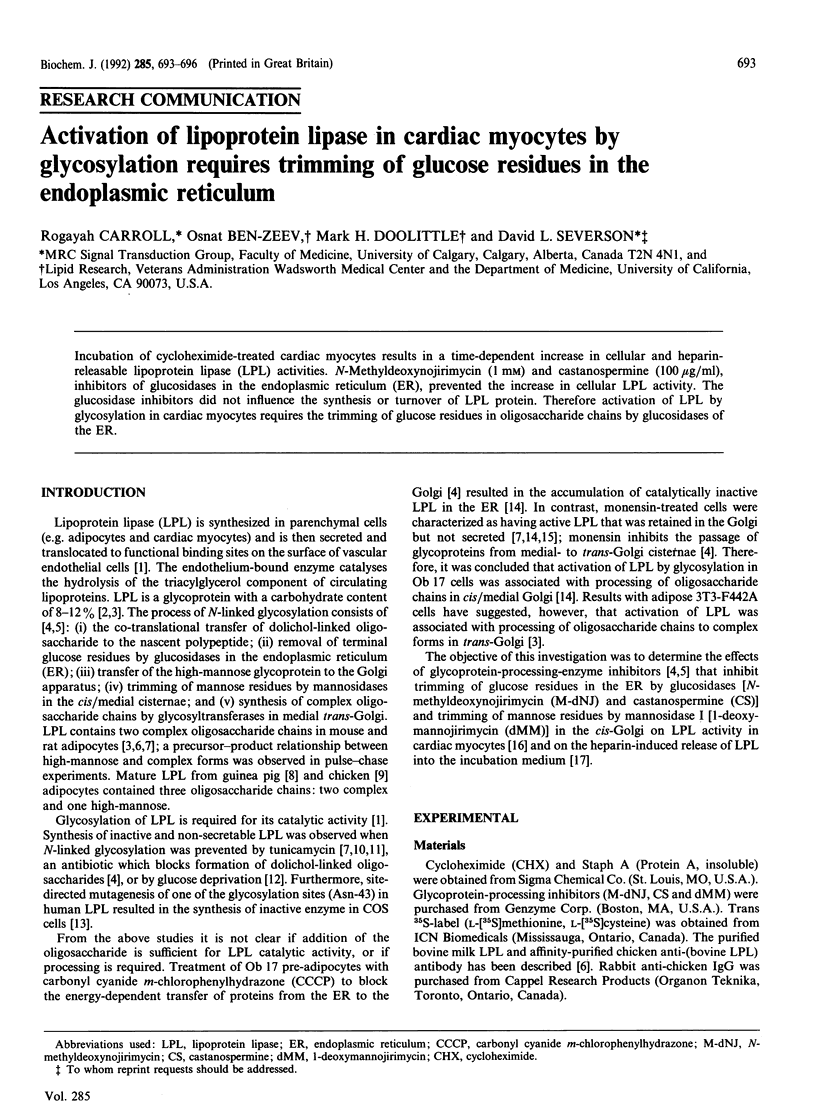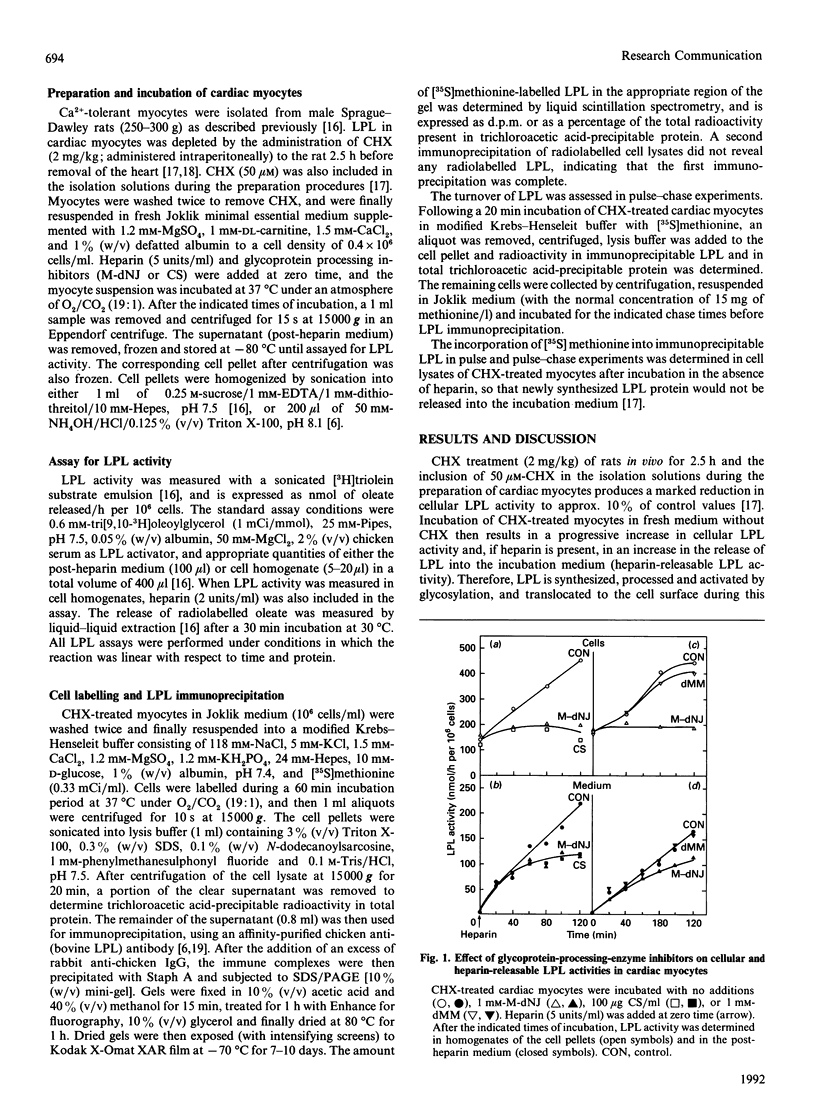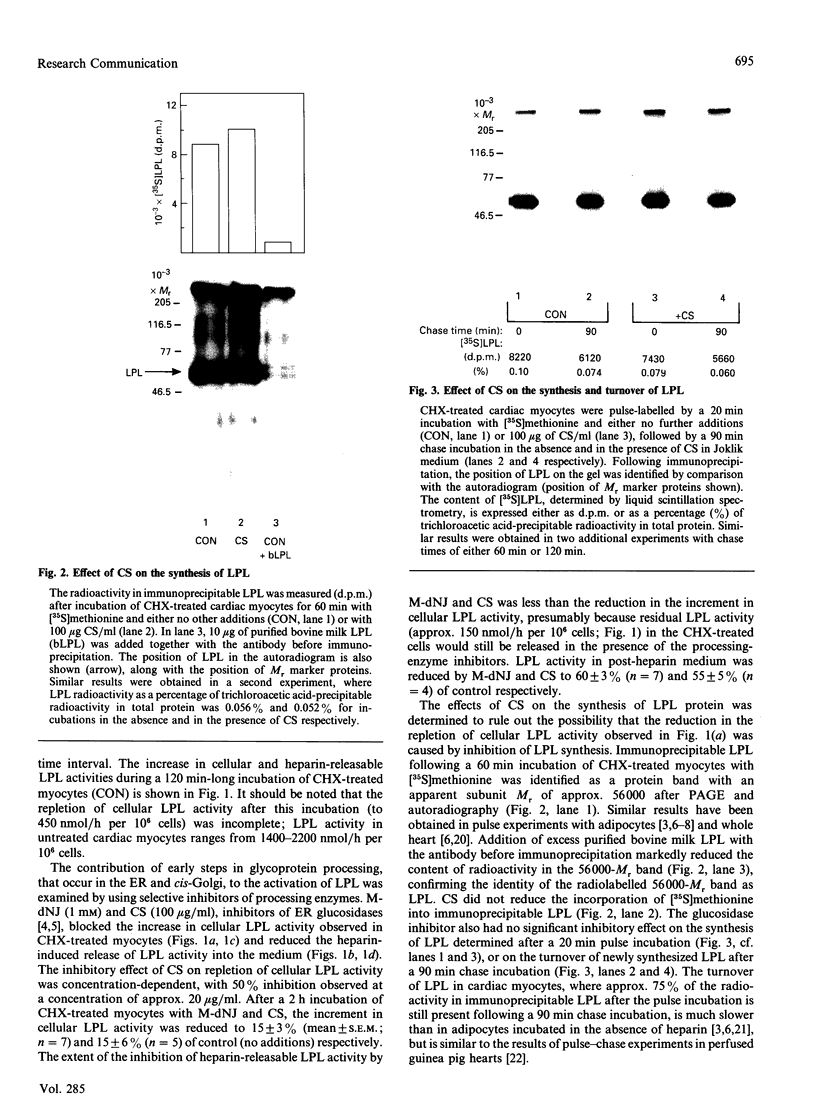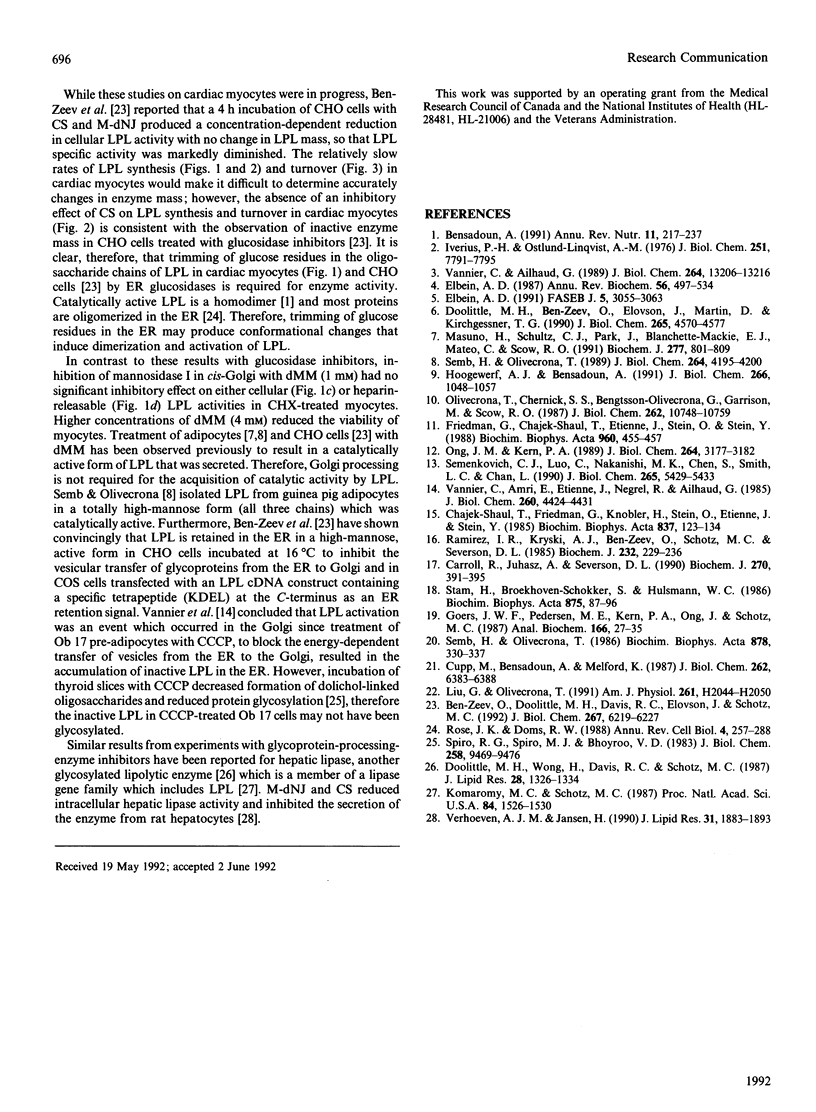Abstract
Incubation of cycloheximide-treated cardiac myocytes results in a time-dependent increase in cellular and heparin-releasable lipoprotein lipase (LPL) activities. N-Methyldeoxynojirimycin (1 mM) and castanospermine (100 micrograms/ml), inhibitors of glucosidases in the endoplasmic reticulum (ER), prevented the increase in cellular LPL activity. The glucosidase inhibitors did not influence the synthesis or turnover of LPL protein. Therefore activation of LPL by glycosylation in cardiac myocytes requires the trimming of glucose residues in oligosaccharide chains by glucosidases of the ER.
Full text
PDF



Images in this article
Selected References
These references are in PubMed. This may not be the complete list of references from this article.
- Ben-Zeev O., Doolittle M. H., Davis R. C., Elovson J., Schotz M. C. Maturation of lipoprotein lipase. Expression of full catalytic activity requires glucose trimming but not translocation to the cis-Golgi compartment. J Biol Chem. 1992 Mar 25;267(9):6219–6227. [PubMed] [Google Scholar]
- Bensadoun A. Lipoprotein lipase. Annu Rev Nutr. 1991;11:217–237. doi: 10.1146/annurev.nu.11.070191.001245. [DOI] [PubMed] [Google Scholar]
- Carroll R., Juhasz A., Severson D. L. Treatment of cardiac myocytes with 8-(4-chlorophenylthio)-adenosine 3',5'-cyclic monophosphate, forskolin or cholera toxin does not stimulate cellular or heparin-releasable lipoprotein lipase activities. Biochem J. 1990 Sep 1;270(2):391–395. doi: 10.1042/bj2700391. [DOI] [PMC free article] [PubMed] [Google Scholar]
- Chajek-Shaul T., Friedman G., Knobler H., Stein O., Etienne J., Stein Y. Importance of the different steps of glycosylation for the activity and secretion of lipoprotein lipase in rat preadipocytes studied with monensin and tunicamycin. Biochim Biophys Acta. 1985 Nov 14;837(2):123–134. doi: 10.1016/0005-2760(85)90235-8. [DOI] [PubMed] [Google Scholar]
- Cupp M., Bensadoun A., Melford K. Heparin decreases the degradation rate of lipoprotein lipase in adipocytes. J Biol Chem. 1987 May 5;262(13):6383–6388. [PubMed] [Google Scholar]
- Doolittle M. H., Ben-Zeev O., Elovson J., Martin D., Kirchgessner T. G. The response of lipoprotein lipase to feeding and fasting. Evidence for posttranslational regulation. J Biol Chem. 1990 Mar 15;265(8):4570–4577. [PubMed] [Google Scholar]
- Doolittle M. H., Wong H., Davis R. C., Schotz M. C. Synthesis of hepatic lipase in liver and extrahepatic tissues. J Lipid Res. 1987 Nov;28(11):1326–1334. [PubMed] [Google Scholar]
- Elbein A. D. Glycosidase inhibitors: inhibitors of N-linked oligosaccharide processing. FASEB J. 1991 Dec;5(15):3055–3063. doi: 10.1096/fasebj.5.15.1743438. [DOI] [PubMed] [Google Scholar]
- Elbein A. D. Inhibitors of the biosynthesis and processing of N-linked oligosaccharide chains. Annu Rev Biochem. 1987;56:497–534. doi: 10.1146/annurev.bi.56.070187.002433. [DOI] [PubMed] [Google Scholar]
- Friedman G., Chajek-Shaul T., Etienne J., Stein O., Stein Y. Tunicamycin-treated rat heart cell cultures synthesize an inactive nonreleasable lipoprotein lipase. Biochim Biophys Acta. 1988 Jun 15;960(3):455–457. doi: 10.1016/0005-2760(88)90054-9. [DOI] [PubMed] [Google Scholar]
- Goers J. W., Pedersen M. E., Kern P. A., Ong J., Schotz M. C. An enzyme-linked immunoassay for lipoprotein lipase. Anal Biochem. 1987 Oct;166(1):27–35. doi: 10.1016/0003-2697(87)90541-0. [DOI] [PubMed] [Google Scholar]
- Hoogewerf A. J., Bensadoun A. Occurrence of sulfate in an asparagine-linked complex oligosaccharide of chicken adipose lipoprotein lipase. J Biol Chem. 1991 Jan 15;266(2):1048–1057. [PubMed] [Google Scholar]
- Iverius P. H., Ostlund-Lindqvist A. M. Lipoprotein lipase from bovine milk. Isolation procedure, chemical characterization, and molecular weight analysis. J Biol Chem. 1976 Dec 25;251(24):7791–7795. [PubMed] [Google Scholar]
- Komaromy M. C., Schotz M. C. Cloning of rat hepatic lipase cDNA: evidence for a lipase gene family. Proc Natl Acad Sci U S A. 1987 Mar;84(6):1526–1530. doi: 10.1073/pnas.84.6.1526. [DOI] [PMC free article] [PubMed] [Google Scholar]
- Liu G. Q., Olivecrona T. Pulse-chase study on lipoprotein lipase in perfused guinea pig heart. Am J Physiol. 1991 Dec;261(6 Pt 2):H2044–H2050. doi: 10.1152/ajpheart.1991.261.6.H2044. [DOI] [PubMed] [Google Scholar]
- Masuno H., Schultz C. J., Park J. W., Blanchette-Mackie E. J., Mateo C., Scow R. O. Glycosylation, activity and secretion of lipoprotein lipase in cultured brown adipocytes of newborn mice. Effect of tunicamycin, monensin, 1-deoxymannojirimycin and swainsonine. Biochem J. 1991 Aug 1;277(Pt 3):801–809. doi: 10.1042/bj2770801. [DOI] [PMC free article] [PubMed] [Google Scholar]
- Olivecrona T., Chernick S. S., Bengtsson-Olivecrona G., Garrison M., Scow R. O. Synthesis and secretion of lipoprotein lipase in 3T3-L1 adipocytes. Demonstration of inactive forms of lipase in cells. J Biol Chem. 1987 Aug 5;262(22):10748–10759. [PubMed] [Google Scholar]
- Ong J. M., Kern P. A. The role of glucose and glycosylation in the regulation of lipoprotein lipase synthesis and secretion in rat adipocytes. J Biol Chem. 1989 Feb 25;264(6):3177–3182. [PubMed] [Google Scholar]
- Ramírez I., Kryski A. J., Ben-Zeev O., Schotz M. C., Severson D. L. Characterization of triacylglycerol hydrolase activities in isolated myocardial cells from rat heart. Biochem J. 1985 Nov 15;232(1):229–236. doi: 10.1042/bj2320229. [DOI] [PMC free article] [PubMed] [Google Scholar]
- Rose J. K., Doms R. W. Regulation of protein export from the endoplasmic reticulum. Annu Rev Cell Biol. 1988;4:257–288. doi: 10.1146/annurev.cb.04.110188.001353. [DOI] [PubMed] [Google Scholar]
- Semb H., Olivecrona T. Lipoprotein lipase in guinea pig tissues: molecular size and rates of synthesis. Biochim Biophys Acta. 1986 Oct 3;878(3):330–337. doi: 10.1016/0005-2760(86)90240-7. [DOI] [PubMed] [Google Scholar]
- Semb H., Olivecrona T. The relation between glycosylation and activity of guinea pig lipoprotein lipase. J Biol Chem. 1989 Mar 5;264(7):4195–4200. [PubMed] [Google Scholar]
- Semenkovich C. F., Luo C. C., Nakanishi M. K., Chen S. H., Smith L. C., Chan L. In vitro expression and site-specific mutagenesis of the cloned human lipoprotein lipase gene. Potential N-linked glycosylation site asparagine 43 is important for both enzyme activity and secretion. J Biol Chem. 1990 Apr 5;265(10):5429–5433. [PubMed] [Google Scholar]
- Spiro R. G., Spiro M. J., Bhoyroo V. D. Studies on the regulation of the biosynthesis of glucose-containing oligosaccharide-lipids. Effect of energy deprivation. J Biol Chem. 1983 Aug 10;258(15):9469–9476. [PubMed] [Google Scholar]
- Stam H., Broekhoven-Schokker S., Hülsmann W. C. Studies on the involvement of lipolytic enzymes in endogenous lipolysis of the isolated rat heart. Biochim Biophys Acta. 1986 Jan 3;875(1):87–96. doi: 10.1016/0005-2760(86)90014-7. [DOI] [PubMed] [Google Scholar]
- Vannier C., Ailhaud G. Biosynthesis of lipoprotein lipase in cultured mouse adipocytes. II. Processing, subunit assembly, and intracellular transport. J Biol Chem. 1989 Aug 5;264(22):13206–13216. [PubMed] [Google Scholar]
- Vannier C., Amri E. Z., Etienne J., Négrel R., Ailhaud G. Maturation and secretion of lipoprotein lipase in cultured adipose cells. I. Intracellular activation of the enzyme. J Biol Chem. 1985 Apr 10;260(7):4424–4431. [PubMed] [Google Scholar]
- Verhoeven A. J., Jansen H. Secretion of rat hepatic lipase is blocked by inhibition of oligosaccharide processing at the stage of glucosidase I. J Lipid Res. 1990 Oct;31(10):1883–1893. [PubMed] [Google Scholar]




